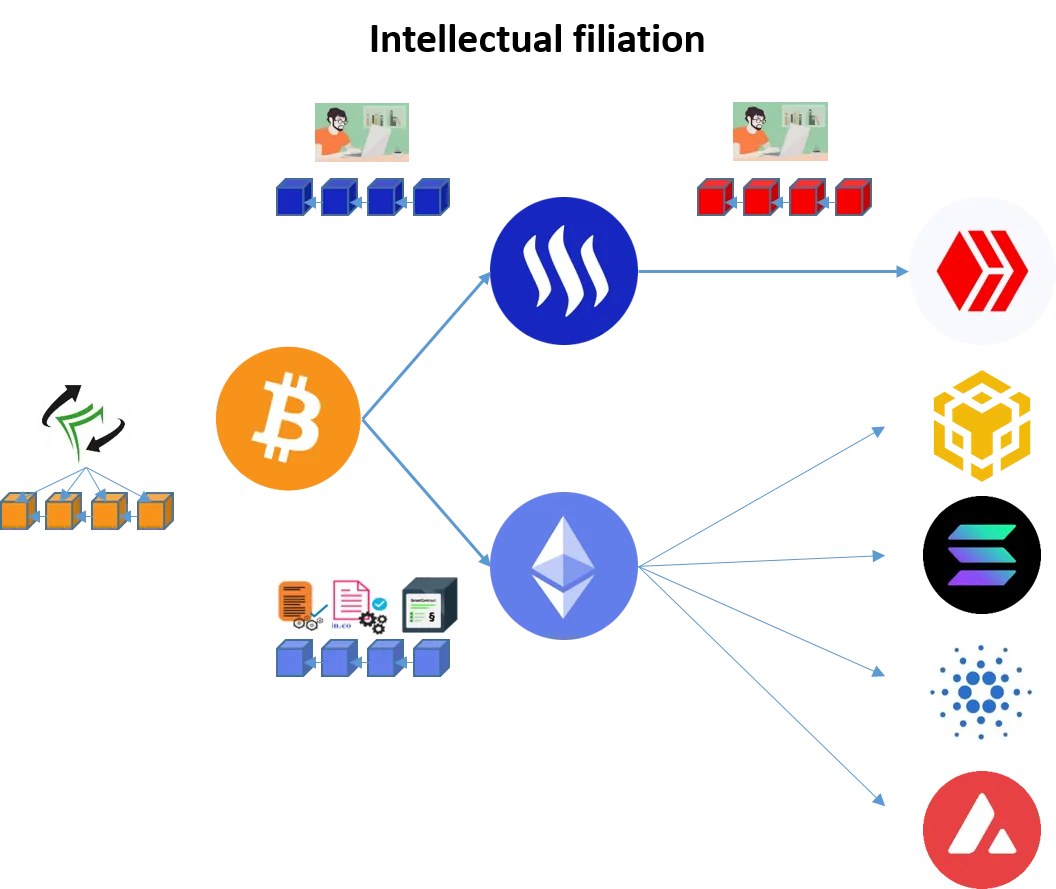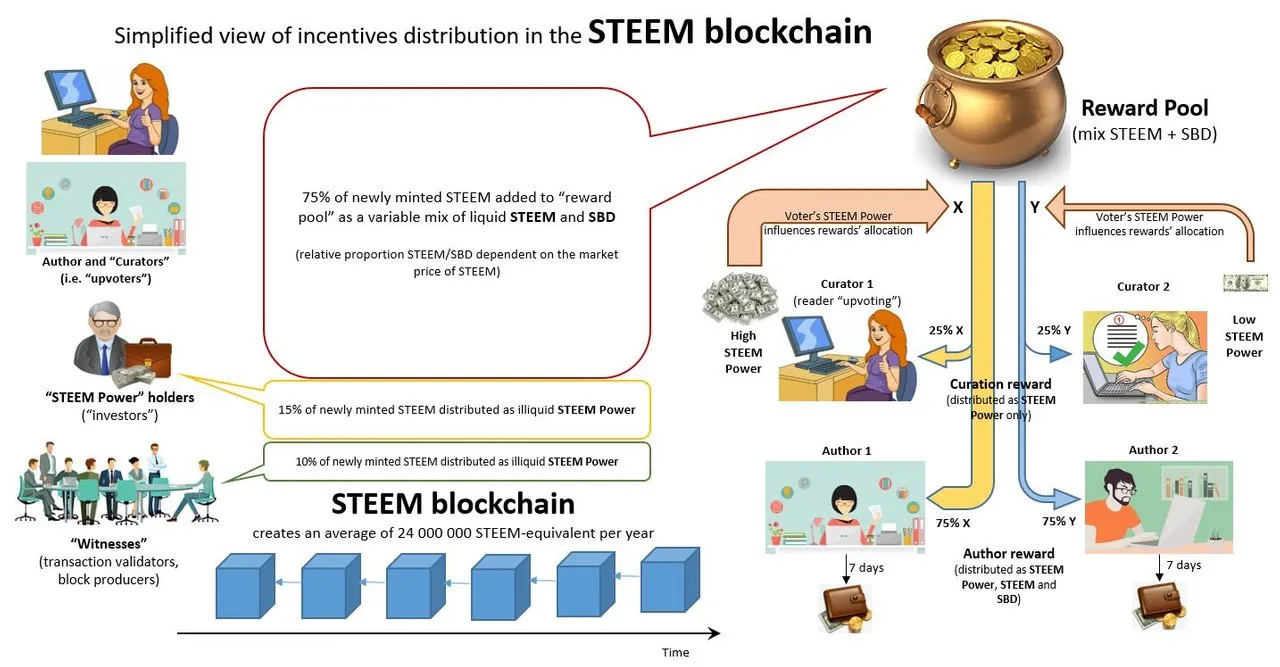Hive** features an unique, advanced economic system - the "most advanced", according to a 2018 analysis in "The Economist". The reason Hive is unique is the different intellectual path taken by the creators of its precursor, Steem, more than six years ago and illustrated below.

The common ancestor, Bitcoin, used a "blockchain" to serve its functional goal: a peer to peer electronic cash system. Seeing the power of the blockchain pattern, the Ethereum team decided to turn it into a platform for general purpose applications, user-designed "smart contracts". In contrast, Steem's creators stood firmly by the approach used by Satoshi Nakamoto: the functional goal came first, and that goal was to build a "content creation and curation platform". Today, in terms of variety, all the new generation blockchains (or almost) use the Ethereum approach, linking a blockchain data structure with a smart contract execution engine. Hive, in turn, shunned user-designed smart contracts and remained true to the original Steem architecture.
An outsider will thus need to approach Hive with an open mind and not assume it will find many similarities with other blockchain systems (save for Steem), as most other blockchains have followed the intellectual lead of Ethereum.
In particular, two features stand out immediately when describing Hive:
- Free transactions
- Reward pool
A more detailed explanation of the Steem mechanism can be found in this paper I wrote several years ago. Although many parameters were changed and others were introduced by Hive, the overall picture remains useful.

Free transactions
Very few other blockchain systems were built from the ground up in order to offer free transactions. Those which were are outliers, such as Nano and IOTA, or have a relationship with Steem / Hive, such as EOS (all three were designed by Dan Larimer). Free, zero-fee transactions are an extremly powerful feature as they allow an user to start using the system with no initial capital outlay. That means a newcomer can start using the a blockchain "dApp" (application) straightaway, without having to buy crypto. Actually, on the hive blockchain, users never have to buy HIVE, which gives power to simple users but is not necessarily well-regarded by investors.
As a downside, free transactions also make the system somewhat more vulnerable to attacks, thus needing honest actors and / or additional protection from the legal system (whereas Bitcoin has been built to not need to rely on the legal system). I have argued that this trade-off makes sense, as it allows community-building.
As Ethereum took inspiration from Bitcoin, I have explained in a previous paper why the Ethereum "smart contracts" actually sit very awkwardly with the legal system, from where the "contract" term has been borrowed. Given the many scams which pullulated on Ethereum and related platforms, "cunning code" would probably better describe these programs.
Reward pool
Bitcoin and Ethereum (and almost all their intellectual progeny) reserve all the newly minted coins to the "miners" / "validators" - people who operate the blockchain, as an incentive to stay honest and keep the network safe. The decade-long demonstration that "economic incentives" can foster human collaboration on a scale only law was able to achieve previously was one of the greatest contribution Satoshi Nakamoto made to the progress of humankind.
The downside of this design is that, governance-wise, these systems turn out to be "computocracies", where the power is not in the hands of the users but rather in those of a new nomenklatura of computer-savvy techies.
Steem had the audacity to reverse that balance with a radical change: it kept only 10 % of newly minted coins for those operating the network (thus further diminishing the potential of the network to resist censorship and increasing its need to rely on honest actors and, potentially, the law). It allocated 15% to those providing "capital", the "investors". And it kept the majority of new coins (75% for Steem, 65% for Hive***) for the users, those creating and curating content. How these coins from the reward pool are directed depends on two things:
- How users "vote" on chain (on-chain governance)
- How much stake voting users avail themselves of.
Note an important subtlety: it's not about "how much stake users own", but about how much they can "command". And here is where the concept of "delegation" takes a whole new dimension and acquires new meanings.
Indeed when mentioning "Delegated Proof of Stake" (DPoS), the consensus used by bitShares, Steem, Hive, EOS and other blockchains, most people only think of the process of electing block validators. And indeed, this is the first use of the DPoS.
But in Steem and Hive's case, the "delegation" mechanism, a type of "secured lending", is further extended with the power of directing the coins located in the reward pool. That mechanism allows division of labour which is arguably the most important step in the emergence of the human civilisation. Thus users with little capital but available time ("labour") can be "delegated" Hive Power (HP) which they can use to more effectively "curate content" (rank content by perceived quality and allocate rewards from the reward pool) or perform other decision-making activities (such as voting on the "decentralized fund" allocation) whose effectiveness increases with the stake applied. This is also explained in the article on Steem crypto economics I wrote almost 4 years ago (and illustrated with a short video) but it takes some to fully understand.
Show me the money
After what amounts to a lengthy introduction, we come to the "meat" of this paper.
You are "an investor"; that is, you bought Hive, moved it to a blockchain account (rather than keeping it on an exchange) and "powered up". The latter is the Hive lingo for "staking": locking liquid Hive in a built-in smart contract where it is seen as "Hive Power" (1 Hive = 1 HP)****
The default choice is to keep the HP there and earn the "inflation rate" (currently 2,92%). The benefit is that you can use that HP whole influence when picking "witnesses" (validator nodes), when voting on the various "development proposals" vying for the 10% of newly minted coins in the DHF (decentralized hive fund) and of course when "curating content" (signaling what posts you enjoyed and getting "curation rewards" for yourself in the process), among other things.
But perhaps you are too busy to do much of that and too "return oriented" to be happy with the meagre 2,92%. Then you can "delegate" fractions or all of your HP through another built-in smart contract: your HP will then become usable by other users (the "delegatees") who might have more time on their hands to put those HP to work (gentle pun: HP is also an abbreviation for "horse power").
As there are several actors who are willing to receive HP delegations and share the resulting yield, you might be wondering whether they are all equally good, or else, which ones to pick? I have in any case. I used to have a truckload of HP delegated to a single service, @tipu. But I noticed the return kept getting smaller and smaller. So about one month ago I decided to embark on a research mission, with the objective of finding out: what are the best delegatees?
Start line
At the start line, on June 6th, I delegated 1000 HP each to the following accounts:
- @tipu
- @ecency
- @qurator
- @ocdb
- @leo.voter
- @curie
- @cristanza42 (through the @dlease marketplace)
- @appreciator
- @actifit
If you have other such worthy delegatees to recommend, do not hesitate to make suggestion in the comments.


I'll discuss each of them in separate posts, but let's start by saying that one month later, @curie had not returned anything in any way so I cancelled the delegation (it doesn't appear in the above screen capture done today, where you can also noticed that the 1000 HP from June have become 1003 HP thanks to the 2,9% inflation).
That leaves 8 competitors to compare.
Finish line
One month later, I would not be doing these great delegatees a service by simply ranking them by return, so I plan to analyse them in detail in a dedicated article. But can't let you hanging either (I'm not Netflix) ...
I can say that @ecency is the best overall, in my opinion, especially if you do have some activity and contribute original content to the platform (on which you can use ecency "points" to boost your article). However, ecency points are no crypto asset and are not tradeable. You can't use more than 500 per article and they bring no guarantee, so the "points" income is not very scalable.
You can get good returns through @dlease but the marketplace is not deep enough for a large amounts of HP and you have little control over the quality of the activity: expect some delegatees to use your delegation to maximise financial return at the expense of quality.
@leo.voter offers nice returns too but they are not in HIVE but in a L2 token, LEO, which you'll need to exchange on a Dex That adds extra work and risk as the liquidity of these L2 tokens is usually low.
@actifit is a nice social delegatee which suffers partly from a similar set up: it returns HIVE and HBD weekly (in moderate quantities) and supplements that return with its own L2 token, AFIT. However that token arrives locked, unlocking is paced and the market for AFIT is illiquid.
Among the next three, @ocdb, @qurator and @tipu, all focused on quality content, @ocdb appears the best but you'll have to take into account a 7 day shift for the returns to start arriving.
The last among the eight, @appreciator is a bit mysterious: it returned a little HIVE and also gave a sizable vote to one of my articles. However, I have no idea why to that article in particular and what articles it votes, so I prefer underweighting it in an allocation.
Here is the Excel sheet where I did my (amateurish) accounting.

Note that I took into account the return for @ocdb until July 12th (assuming tomorrow and Tuesday it will be similar to today). For actifit, I approximated each HBD returned to about 2 HIVE. I took a bid price from Tribaldex to attempt a conversion of AFIT into HIVE. I used @ecency's own estimate of the value of the "points" and I used approximate conversion rates of LEO into HIVE.
Conclusion
I am turning this month-long observation into an allocation which I am going to execute and monitor and will report on in a future article. However, there is a conclusion already: "delegation" in the Hive ecosystem, a type of "secured-lending", supports real social and economic activity rather than financial speculation.
Thus the returns it generates are healthier than those of the typical crypto platform and in the general meltdown of the past three months, it showed!

** Steem is the original blockchain which introduced this economic mechanism design. Hive diverged from Steem in march 2020. An article analysing the difference in fortunes between these two very similar blockchain eco-systems is warranted.
*** Hive has added a DAO-like "decentralized fund", not unlike older blockchain systems such as Decred. The 10% of newly minted coins which are directed there are redistributed to projects selected by the stakeholders.
**** Staked or "powered up" HIVE is actually converted internally in a different cryptoasset called VESTS. But that is only of academic interest, you don't need to worry about that
